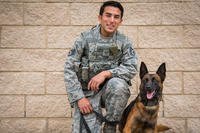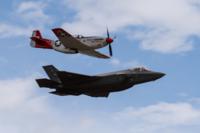Every Veterans Day is a tactical thanksgiving, a time of year when America's chain restaurants open their doors to give away free food to veterans. Any veteran looking to make the most of these offers should look to the experts for advice, just as they would when training for a mission. When it comes to stuffing yourself silly, there's no better source than competitive eaters.
Competitive eating may be a joke to some, but for champions like Molly Schuyler, Joey Chestnut or Jamie "The Bear" McDonald, it's a record-setting, money-winning way of life.
Still, like all great competitors, they have to train. While veterans might not be in Chacho's World Taco Eating Championship, these tips might help them make it through Applebee's, TGI Friday's and Red Lobster on the same day.
Read: 2022 Veterans Day Free Meals and Restaurant Deals and Discounts
1. Train Your Stomach to Expand.
The week of Veterans Day might be a bad time to start training, but it's never too soon to get started for next year. The first step is teaching your stomach to handle more and more food before telling your brain it's full.
Competitive eaters do this by drinking progressively larger amounts of water over short periods of time. One scientific medical journal described the process as turning the stomach into "an enormous flaccid sac capable of accommodating huge amounts of food."
2. Stay in Shape.
This is one area where most military members are ahead of the game. Many competitive eaters note that their ability to pack away the food in competition can fluctuate with how much body fat they carry around. As a result, most world champions are not obese at all; many are actually in good shape.
Behind this is the "belt of fat" theory, a purely anecdotal theory that postulates that belly fat will restrict the stomach's ability to expand. Many competitive eaters maintain a strict diet and exercise regimen when not training or competing.

3. Strengthen Your Jaw.
Like any athlete, competitive eaters need to work certain muscles longer, faster and more efficiently than other humans do in normal life. This requires training, specifically of the parts of the eater's body that will be doing the most work: their mouth. It takes a lot of work to consume 63 hot dogs in 10 minutes, the rate that won Chestnut the 2022 Nathan's Hot Dog Eating Contest.
Eaters will work out those jaw muscles by practicing chewing, often on the same silicon tubes used by patients recovering from jaw surgery. They will also chew unnatural amounts of gum, as many as 20 pieces at once.
4. Perfect Your Stance.
There are actually certain positions that can compress the stomach or otherwise limit the amount of food your body can take before telling the brain, "Game over." One of the most obvious ways to compress the stomach is by sitting, which is why most true competitive eaters stand during competition.

Standing also makes it easier to breathe, which is important while stuffing your face for 10 minutes at a time. Some competitive eaters will also jump up and down periodically to keep food moving and prevent choking hazards.
5. Practice Water Discipline.
This doesn't mean minimizing the amount of water you drink. Liquid is actually an important part of competitive eating. Your body isn't going to make enough saliva to lubricate 28.5 gyros in 10 minutes, but liquid takes up space, so you have to use it efficiently.
Matthew "The Megaton" Stonie prefers hot PowerAde, because cold water can constrict the muscles in your throat. No matter what fluid you use, some contests forbid drinking liquids at all, but allow the food to be moistened with water -- so learning to use liquid appropriately is an important skill.
6. Move with Purpose.
When attempting to eat 430 wings in 30 minutes, like eaters do during Philadelphia's Wing Bowl, it means putting away at least 14 wings per minute. Basic training programs veterans to eat fast, but not efficiently. Competitive eaters developed a series of eating methods that allow them to ingest foods at a rate that can best be described as "efficient" and, at worst, "unholy."
Takeru Kobayashi created the Solomon Method of hot dog eating, which involves breaking the dog in half and grinding it with his molars while downing a moistened bun and moving the next glizzy into place. Arnie "Chowhound" Chapman uses a similar method with pickles that he dubbed "the Woodchipper."
No matter how you spend your Veterans Day, either casually eating like a normal person might or buzzing through free Veterans Day food like a competitive eater on speed, be safe, have fun and tip the serving staff. Remember: You're representing all veterans that day.
-- Blake Stilwell can be reached at blake.stilwell@military.com. He can also be found on Twitter @blakestilwell or on Facebook.
Want to Learn More About Military Life?
Whether you're thinking of joining the military, looking for post-military careers or keeping up with military life and benefits, Military.com has you covered. Subscribe to Military.com to have military news, updates and resources delivered directly to your inbox.














